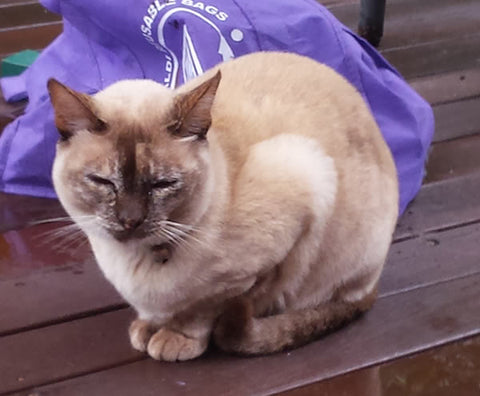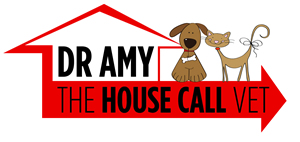Low Stress Handling Part 2 - animal behaviour June 21, 2015 22:01 1 Comment

The first step in being able to handle animals in a non stressful and even enjoyable manner, is to be able to recognise the early signs of anxiety that they display. If/when they occur, we can stop the action that was causing the pet concern, and consider an alternative approach.
In future blog posts I will delve into what you and I can do to minimise the occurence of these signs (and how to deal with them if they do show up), but today, let's concentrate on the signs themselves.
This is Lara. Here she is nice and relaxed on her outside couch, in the morning sun:

Her ears are forward, her head and eyes are facing me, her neck and jaw are relaxed - happy dog!
Here she is a little worried - my three year old daughter has taken this photo, and Lara's unsure if she's trustworthy, poking a camera in her face:

Her eyes are turned a little sideways, her ears are back a little, and she's a bit tense in the neck. These are classic early signs of anxiety. While they won't show in a photo, she was displaying a few anxiety related behaviours at this stage too - licking her lips, moving in slow motion, keeping her tail still, and then once it was over and Rosie and the camera went away, she had a good general body shake.
It is amazing how often owners incorrectly interpret their pet's behaviour! Many people assume that their pet holds still for the vet because they are "being good", when they are actually exhibiting the classic signs of anxiety: slow motion movement and general body stiffness. Don't get me wrong, they are being good, but they are also scared. It's actually better (as far as indicating your pet's mental state) if they are a bit wriggly and curious. And yet so often pets are reprimanded for investigating my box, finding my treats and being "nosey".
Here's an easy one:

Monty was happy relaxed and friendly during his checkup and vaccination. However when I wanted to take a photo of him, and his owner told him to sit, he became anxious. I'm not sure whether he is afraid of cameras, or just got worried about why he had to sit. Whatever the exact cause, you can clearly see from his lowered head, ears down and back a little, and eyes and head turned slightly away from me, that he is worried. Note: lots of people would think he looks guilty. Usually when people think their dog looks guilty, they are simply anxious. Maybe because you're telling them off?
Some early signs of anxiety or fear are actually normal behaviours, done in an abnormal setting. Some really good examples are panting when you're not hot and shivering when you're not cold.
A lot of barking is anxiety fuelled. Often people think their dogs are being territorial or protective, when actually they are expressing anxiety. When I arrive at a house for a vet visit and a dog barks at me for a while, owners often say "haha, he's just letting you know this is his house." I don't argue, however this is usually not the case. Usually they are anxious about this person (me) coming into their space, who smells like other pets and carries an unusual box and bag. Once I have spent a few minutes talking calmly to their owners, while leaving my box on the floor a few steps away, they have often decided for themselves that my box is actually really interesting, and even better, contains treats, and that I'm just a new family friend who has come over for a catch up. Then they come to decide I am not a threat. They lose the anxiety, stop the barking and enjoy investigating and eating all my liver treat supplies. Depending on how brave or fearful they are, they may become anxious again when it's time for me to examine them. This could result in barking again, or other more subtle signs of anxiety.
Cats usually show some early signs of anxiety we can look out for as well. Here's Crumpet:
 She has hunched herself up into a tiny little ball, with her tail wrapped close around her body and her head drawn in. If she was cold, this could be normal, warming behaviour. If she's not cold, then she is probably anxious. In this case she was being approached by someone she is not sure is trustworthy. Here she is an instant later when that person continued to advance on her:
She has hunched herself up into a tiny little ball, with her tail wrapped close around her body and her head drawn in. If she was cold, this could be normal, warming behaviour. If she's not cold, then she is probably anxious. In this case she was being approached by someone she is not sure is trustworthy. Here she is an instant later when that person continued to advance on her:

Her ears are sideways. That's a big tell tale sign. If a cat turns their ears sideways and begins to flatten them back, they are not comfortable. In this situation, because she was not boxed in, Crumpet walked off very shortly after this photo was taken. If she couldn't get away she would have turned and hissed at the threatening person. If even that didn't get the message across, and she was really cornered, she would be prepared to bite them when they got too scarey.
One thing I found when I first started doing housecalls back in 2007 was that many cats are more difficult to manage in their own homes. They wriggle and squirm, walk off, and generally feel they are in charge. Whereas in the vet clinic, many just sit without moving, then scuttle back into their cat box as soon as they can. I now know why this is: the cats who are "freezing" in the clinic are really scared. It makes it easy for the vet, but it's not great for the pet's mental or physical health. Each time you are scared and something negative happens to you, the result is that next time you are in that same situation, you will be more scared. And at some point, many of those cats switch from anxiety making them freeze, to a state of terror which triggers their survival instinct of fight or flight. If they choose "fight", then vet care becomes extremely challenging, sometimes impossible, and certainly traumatic. So I would rather shut myself in your laundry with your confident cat (I can't quite let them roam the entire house or I would lose them) and follow him/her around amongst your washing baskets while I examine and vaccinate them, than have them "frozen" on an examination table in front of me!

Laundries/ensuites/walk-in-robes/bedrooms/toilet rooms - I've seen it all!
So lets make a list of the common early signs of anxiety, firstly in dogs:
Body postures - ears down or back, eyes sideways, head lowered or turning away from you, tense jaw, tense neck muscles, tense body generally, tail down, weight leaning back on hind legs,
Actions - licking lips, yawning, panting when not hot, moving in slow motion or not at all, fussing or doing unusual fidgety movements, shivering/shaking when not cold, shaking off (like as if they are wet), refusing to eat when they are actually hungry, barking, hiding or refusing to approach.
And for cats:
Body postures - hunched, feet tucked under, tail wrapped around. Ears sideways or backwards. Fur fluffed up. Leaning away form you.
Actions - hiding, freezing, moving to the furthest possible place from the threat, scrunching up against a wall, tail flicking, walking with bent legs so they are low to the ground, hiding
You may have noticed that some of these signs are contradictory. Moving in slow motion and fidgeting are impossible to do at the same time! Some dogs may do one, and other dogs may do another. There are many more signs that our pets may be displaying - individuals may have their own unique body language. The ones I have listed are just the common ones that we see frequently, however when handling pets, we always try to learn their own personal expressions and adapt to them.
And once again, why do we care about these signs of anxiety? Because if we ignore them, the pet will often escalate their response, which can lead to aggression and injury. And because we are aiming to have your pet as relaxed and happy during veterinary visits as possible - obviously that's more effective in the long run, as well as being much more fun for everyone.

Dr Amy Coles

Comments
Michele Michael on June 22, 2015 09:57
Well written Dr Amy! Very interesting read. :)